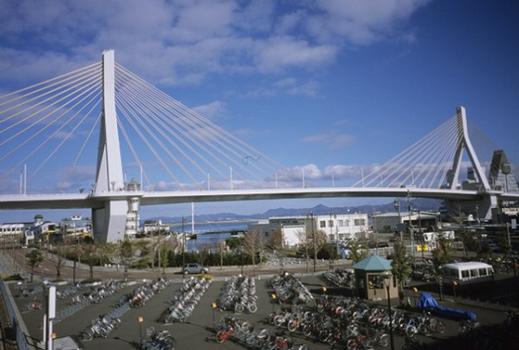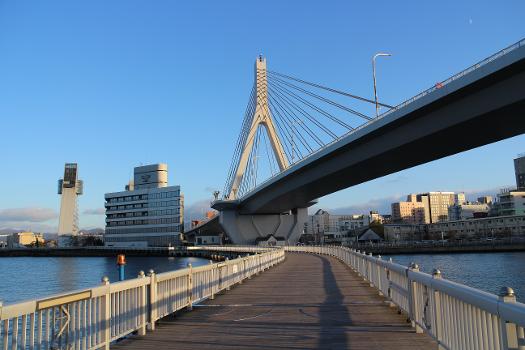General Information
| Name in local language: | 青森ベイブリッジ (Aomori Bei Burijji) |
|---|---|
| Beginning of works: | 1985 |
| Completion: | 1992 |
| Status: | in use |
Project Type
| Structure: |
Cable-stayed bridge with semi-fan system |
|---|---|
| Secondary structure(s): |
Structurae Plus/Pro - Subscribe Now! Structurae Plus/Pro - Subscribe Now! |
| Function / usage: |
Road bridge |
| Material: |
main bridge: Prestressed concrete bridge Structurae Plus/Pro - Subscribe Now! approach viaducts: Steel bridge Structurae Plus/Pro - Subscribe Now! |
Awards and Distinctions
| 1992 |
for registered users |
|---|
Location
| Location: |
Aomori, Aomori, Japan |
|---|---|
| Location description: |
Across Aomori Bay |
| Coordinates: | 40° 49' 48.87" N 140° 44' 12.08" E |
Technical Information
Dimensions
| main span | 240.0 m | |
| total length | 1 219.0 m |
Materials
| piers |
reinforced concrete
|
|---|---|
| pylons |
high performance concrete
|
| deck of main bridge |
prestressed concrete
|
| deck of approach viaducts |
steel
|
Excerpt from Wikipedia
The Aomori Bay Bridge (青森ベイブリッジ, Aomori Bei Burijji) is a cable-stayed bridge in Aomori, Aomori Prefecture, Japan. It was constructed in order to alleviate cargo ship traffic. It is a very notable part of Aomori's skyline.
Details
The Aomori Bay Bridge is the longest bridge in the city of Aomori at 1219 meters. It's the second-longest bridge in Aomori Prefecture after the 1323.7 meter Hachinohe Ōhashi Bridge. Previously the longest bridge in Aomori City was the 993.9 meter Aomori West Bypass overpass, it's now the third longest bridge in Aomori Prefecture.
Emphasis was placed on the aesthetics of the bridge, causing the total cost of construction to come to approximately 27 billion yen (¥) in comparison to only ¥8.9 billion for the longer Hachinohe Ōhashi Bridge. An example of the emphasis on the bridge's appearance is the emblazoning of the letter "A", for "Aomori", at various places such as the base of the bridge and in the shape of the suspension cables. The use of the letter "A" continues on from the nearby Aomori Prefecture Sightseeing Products Mansion, or ASPAM Building, which is built in the shape of a triangle so that it would look like the initial "A".
The bridge's main towers are made from high strength concrete.
In response to the bridge's long standing problems with ice in the winter months, a plan was made to lay pipes circulating sea water under the road surface to melt the ice. However, due to problems related to the cost and construction time, only one section was able to be completed. As yet there are no indications of when the system will be implemented over the remainder of the bridge as originally planned. Even so, since the installation of the system the number of traffic accidents has drastically decreased.
Development
- 1982 – Project created (Project name: Aomori Port Improvement Project, planned to bridge a 1993-meter section)
- 1985 – Construction begins on the bridge.
- 1992 – July – Tentatively, two lanes are opened for traffic. The project receives the Doboku Gakkai Tanaka Award presented by the Japan Society of Civil Engineers for outstanding bridge construction projects.
- 1994 – July – All four lanes are opened for traffic.
- 2002 – Projects to increase earthquake resistance and to install a de-icing system begin. (Project name: Aomori Port Area Bridges (Earthquake Proofing), total budget of approximately 2.5 million yen.)
- 2004 – December - De-icing systems begin being used on 442 meters of the downhill part of the Okidate side (West side) of the bridge.
- 2006 – February – De-icing systems begin being used on 138 meters near the intersection of the Hon-machi side (East side). 253 meters of de-icing systems are planned to begin being used from the Hon-machi side to the Okidate side during the winter of 2006.
Text imported from Wikipedia article "Aomori Bay Bridge" and modified on 13 September 2020 according to the CC-BY-SA 3.0 license.
Participants
Currently there is no information available about persons or companies having participated in this project.
Relevant Web Sites
Relevant Publications
- (1991): Design and construction of Aomori Bay Bridge. Presented at: IABSE Symposium: Bridges - Interaction between construction technology and design, Leningrad, USSR, 1991, pp. 271-276.
- (1993): 『青森県・臨港道路2号線』青森ベイブリッジの景観照明. Flood lighting of the Aomori bay bridge. In: Journal of the Illuminating Engineering Institute of Japan, v. 77 ( 1993), pp. 146-146.
- About this
data sheet - Structure-ID
20006610 - Published on:
07/11/2002 - Last updated on:
26/12/2021








